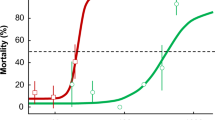Abstract
A common class of fungicides are the ethylene bisdithiocarbamates (EBDCs) which decompose into ethylene bis-isothiocyanate sulfide (EBIS). EBIS is the primary fungitoxic component which is effective on various life stages of oomycete fungi, including zoospores (primary infection agents of oomycete fungal diseases). It is hypothesized that increased fungicide effectiveness can occur if zoospores are attracted to the toxicant (site of fungicide deposition) through chemotaxis using zoospore attractants (ZAs). Several probe studies proved this hypothesis when a ZA was formulated with EBDC products. A highly effective zoospore attractant is isovaleraldehyde (IVA), but IVA is volatile and dissipates rapidly in the environment. Therefore, various precursors for IVA and EBIS were studied to characterize the transient production and decline of EBIS and IVA from precursor material. First-order kinetic material balances and a stochastic modeling tool are created to fully exploit the conditions when the overlap of EBIS and IVA is maximized. A metric is proposed (measure of the overlap of fungicide and ZA residue) as an indirect measure of the potential for preventative fungicide efficacy when ZAs are included within the formulation. Therefore, fungicide formulations containing a ZA can be designed through model deployment that considers the production and decline patterns of both the fungicide and ZA, and the daily environmental dew cycle responsible for achieving the maximum concentration overlap when zoospores are the most infectious (e.g., mobile in the presence of dew) for enhanced crop disease control. It is found that the poly-IVA produrg investigated provides the maximum overlap of EBIS and IVA residues for many different EBDC formulations investigated. This modeling approach, and the examples provided for EBIS and IVA material balances, can be expanded for different fungicides and ZAs allowing for cause/effect to be inferred from multiple interacting factors, and formulations can be designed for optimal release characteristics that maximize the overlap of fungitoxic material and zoospore attractant.














Similar content being viewed by others
References
Adams, M. J., & Swaby, A. G. (2008). Factors affecting the production and motility of zoospores of Polymyxa graminis and their transmission of barley yellow mosaic virus (BaYMV). Annals of Applied Biology, 112(1), 69–78.
Cameron, J. N., & Carlile, M. J. (1978). Fatty acids, aldehydes and alcohols as attractants for zoospores of Phytophthora palmivora. Nature, 217, 448–449.
Cameron, J. N., & Carlile, M. J. (1981). Binding of isovaleraldehyde, an attractant, to zoospores of the fungus Phyphthora palmivora in relation to zoospore chemotaxis. Journal of Cell Science, 49, 273–281.
Donaldson, S. P., & Deacon, J. W. (1993). Effects of amino acids and sugars on zoospore taxis, encystment and cyst germination in Pythium aphanidermatum (Edson) Eitzp., P. catenulatum Matthews and P. dissotocum Drechs. Neu- Phytol, 123, 289–295.
Ehr, RJ, Pearson NR, Ross, Jr. R and Schobert C, Compositions and methods to control oomycete fungal pathogens, Patent application number: U.S. 20090246293, 10/01/2009 (2009)
Ruiz Suárez, E., Geissen, E. L., Jarquín Sánchez, A., Castro Chan, R., & Bello-Mendoza, R. (2013). Formation and decay of ethylenethiourea (ETU) in soil and water under tropical conditions. Journal of Plant Nutrition and Soil Science, 176(1), 40–46.
Hickman, C. J. (1970). Biology of Phytophthora zoospores. Phytopathology, 60, 1128–1135.
Khew, K. L., & Zentmeyer, G. A. (1973). Chemotactic response of zoospores of five species of Phytophthora. Phytopathology, 63, 1511–1517.
Pearson N R, L. Liu L, Ehr RJ, and Atkinson JM. Compositions and methods to control oomycete fungal pathogens, Patent application number: U.S. 20110086761A1: 04/14/201 (2011)
Pearson, NR, . Ross, Jr. R and R.J. Ehr, Compositions and methods to control fungal pathogens, Patent application number: U.S.201002549361, 10/07/2010 (2010)
Press WH, Flanner BP, Teukolsky SA and Vetterling WT, Numerical recipes, the art of scientific computing. Cambridge University Press: New York, 818 pp. (1989)
Tyler, B. M., Wu, M. H., Wang, J., Cheung, W., & Morris, P. F. (1996). Chemotactic preferences and strain variation in the response of Phytophthora sojae zoospores to host isoflavones. Applied and Environmental Microbiology, 62, 2811–2817.
Acknowledgments
Field colleagues Brian Olson and Valentino Bosco provided historical daily leaf wetness duration data for New York and Italy locations, respectively, which were used to describe probability density functions in the stochastic model. Todd Mathieson took several of the photographs, and Dr. Karl Schnelle and Dr. Anthony Altieri provided technical feedback on the manuscript. The authors were employees of Dow AgroSciences LLC and this research was supported by Dow AgroSciences. J. Quinn performed many of the mancozeb dissipation experiments in water while employed at Rohm and Haas agricultural chemicals Co., Spring House PA (a company purchased by Dow AgroSciences in 2001).
Author information
Authors and Affiliations
Corresponding author
Rights and permissions
About this article
Cite this article
Cryer, S.A., De Boer, G., Pearson, N. et al. Modeling Ethylene Bisdithiocarbamate Efficacy Potential in the Presence of a Zoospore Attractant. Environ Model Assess 21, 467–478 (2016). https://doi.org/10.1007/s10666-015-9496-9
Received:
Accepted:
Published:
Issue Date:
DOI: https://doi.org/10.1007/s10666-015-9496-9




